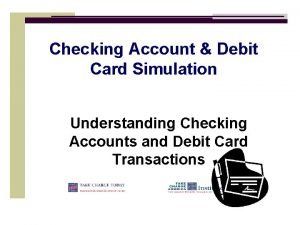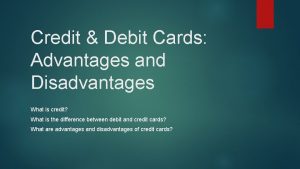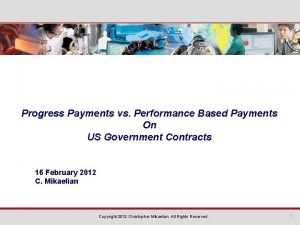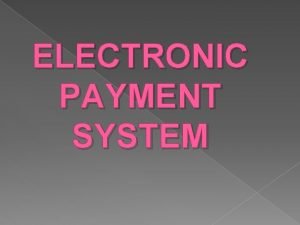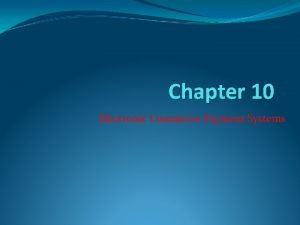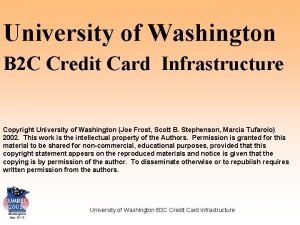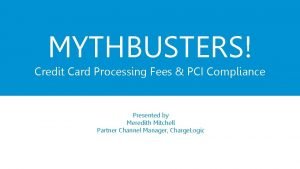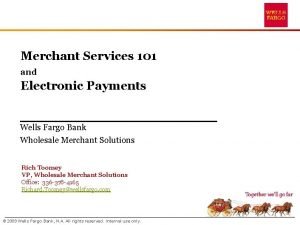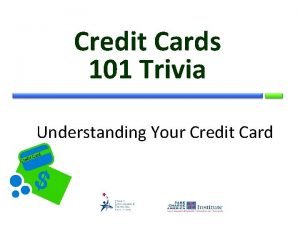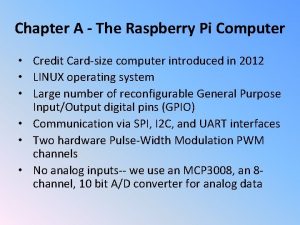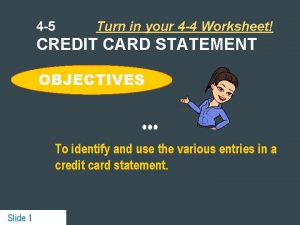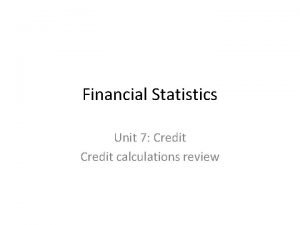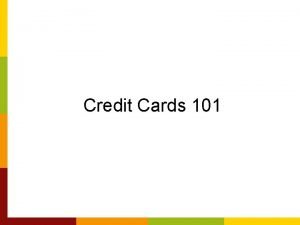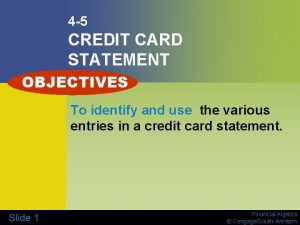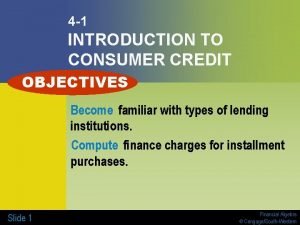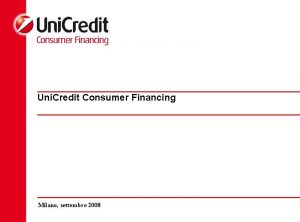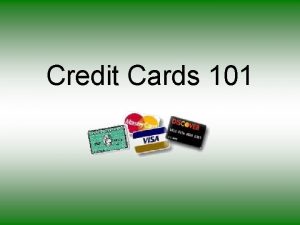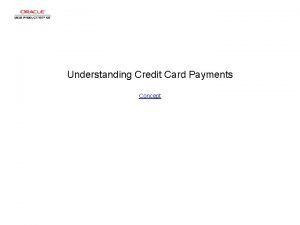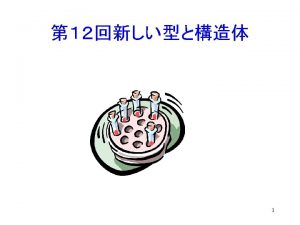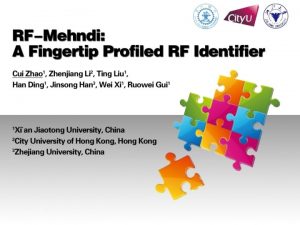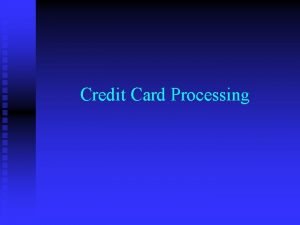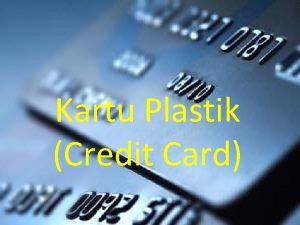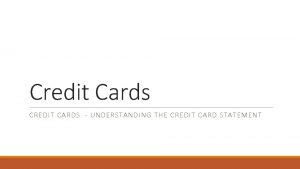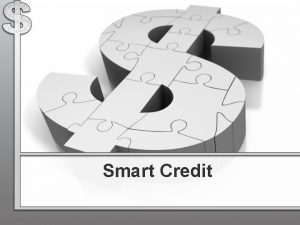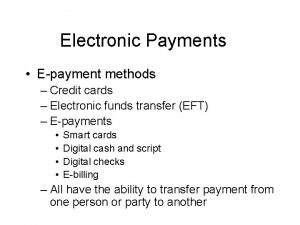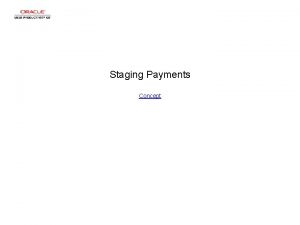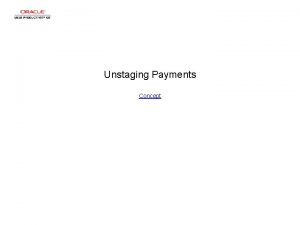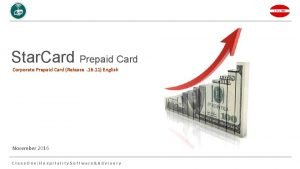Electronic payments Outline credit card payments over the


























- Slides: 26

Electronic payments

Outline § credit card payments over the Internet – using SSL – using SET § electronic cash – Chaum’s untraceable e-cash based on blind signatures – detection of double spending § micropayments – the Pay. Word scheme – probabilistic payment schemes of Micali and Rivest 2

Credit card payment using SSL § the user visits the merchant’s web site and selects goods/services to buy – state information may be encoded in cookies or in specially constructed URLs – or state information may be stored at the merchant and referenced by cookies or specially constructed URLs § the user fills out a form with his credit card details § the form data is sent to the merchant’s server via an SSL connection SSL – merchant’s server is authenticated – transmitted data is encrypted § the merchant checks the solvency of the user § if satisfied, it ships the goods/services to the user § clearing happens later 3

Problems § eavesdropping credit card numbers is not the real risk § the real risk is that credit card numbers are stolen from the merchant – they might be obtained by breaking in the merchant’s computer on which the numbers are stored – this happened with CD Universe in ? ? § who should care about this? SSL – the users are liable only for a fixed amount – the issuer bank pays for the fraud banks (and indirectly credit card companies) should care 4

SET – Secure Electronic Transactions § a protocol designed to protect credit card transactions on the Internet § initiated and promoted by Master. Card and Visa § many companies were involved in the development of the specifications (IBM, Microsoft, Netscape, RSA, Veri. Sign, …) § the SET specification consists of three books: SET 1. Business Description 2. Programmer’s Guide 3. Formal Protocol Definition – around 1000 pages 5

SET services § confidentiality – cardholder account and payment information is secured as it travels across the network – cardholder account and payment information (e. g. , credit card number) is hidden from the merchant too ! § integrity – messages cannot be altered in transit in an undetectable way – based on digital signatures § cardholder account authentication – merchant can verify that the client is a legitimate user of the card – based on X. 509 certificates SET § merchant authentication – client can authenticate the merchant and check if it is authorized to accept payment cards – based on X. 509 certificates 6

Model merchant cardholder order info + payment instruction ack + services Internet authorization request authorization capture response + request capture token ing cess o r p ation z i r o ssing auth e c o r re p capture response payment gateway payment network SET money transfer issuer acquirer 7

SET participants § cardholder – wants to buy something from a merchant on the Internet – authorized holder of payment card issued by an issuer § merchant – sells goods/services via a Web site or by e-mail – has a relationship with an acquirer § issuer – issues payment cards – responsible for the payment of the dept of the cardholders § acquirer – maintains accounts for merchants – processes payment card authorizations and payments – transfers money to the merchant account, reimbursed by the issuer SET § payment gateway – interface between the Internet and the existing bankcard payment network for authorization and payment functions § CAs 8

Dual signature § links two messages that are intended for two different recipients data 1 K-1 X hash data 2 hash data 1 SET sign data 2 9

Payment processing overview cardholder (C) merchant (M) PI OI C C PI KP payment gtw (P) Auth. Req. C M KP KP * Cap. Token Ack Auth. Res. P P KM KP M * Cap. Token SET OI PI Order Info. Payment Inst. M signature C dual signature KP digital envelop Cap. Req. P KP Cap. Res. M KP * P KM 10

Untraceable e-cash § electronic coins: ( serial_number, Sig. K(serial_number) ) 1 bank § problemuser of traceability merchant spend coin sn deposit coin sn (merchant is identified in order to credit his account) e-cash withdraw coin sn (user is identified in order to debit her account) bank can link the withdrawal (identity of the user) and the deposit (identity of the merchant) via the serial number sn 11

Untraceable e-cash cont’d § making it untraceable: blinded RSA signatures – U generates a random number r – U computes h(coin_data) * r. PK(B) and sends it to B – B signs the blinded coin by computing ( h(coin_data) * r. PK(B) )SK(B) = h(coin_data)SK(B) * r – when U receives the blindly signed coin it removes the blinding h(coin_data)SK(B) * r-1 = h(coin_data)SK(B) – the rest of the protocol (spending and deposit) is the same as before e-cash § the bank cannot link r * h(coin_data)SK(B) and h(coin_data)SK(B) together (r is random) 12

Micropayments § special payment protocols developed for very low value transactions § usual examples include – – – paying for web pages visited paying for downloaded fragments of a song, movie paying for news, articles from a digital journal encourage sharing in peer-to-peer networks … micropayments § not very successful so far – people are used to get these kind of things free of charge – if they have to pay, they prefer the subscription model 13

Pay. Word § representative member of the big family of hash chain based micropayment schemes § players – user (U) – vendor (V) – broker (B) § credit based – payment tokens are redeemed off-line micropayments § uses public key crypto, but very efficiently (in case of many consecutive payments to the same vendor) – user signs a single message at the beginning – this authenticates all the micropayments to the same vendor that will follow § developed by Rivest and Shamir in 1996 14

Registration phase § § micropayments § U registers with a broker B B issues a certificate for U CU = { B, U, addr. U, KU, exp, more_info }KB-1 the certificate is a statement by B to any vendor that B will redeem authentic paywords (micropayment tokens) produced by U turned in before the expiration date 15

Payment phase § commitment – when U is about to contact a new vendor, she computes a fresh payword chain wn, wn-1 = h(wn), wn-2 = h(wn-1) = h(2)(wn), … , w 0 = h(n)(wn) where micropayments • n is chosen by the user • wn is picked randomly – U computes a commitment M = { V, CU, w 0, date, more_info }KU-1 – the commitment authorizes B to pay V for any of the paywords w 1, …, wn that V redeems with B before the given date – note: paywords are vendor specific, they have no value to another vendor 16

Payment phase cont’d micropayments § payment tokens – the i-th payment from U to V consists of the i-th payword and its index (wi, i) – when V receives wi, it can verify it by checking that it hashes into wi-1 (received earlier or in the commitment in case of i = 1) – since the hash function is one-way (preimage resistant) the next payment wi+1 cannot be computed from wi – V needs to store only the last received payword and its index – variable size payments can be supported by skipping the appropriate number of paywords • let’s assume that the value of each payword is 1 cent • and the last payword that U sent is (wk, k) • if U wants to perform a payment of 10 cents, then she sends 17 (wk+10, k+10)

Redemption phase micropayments § at the end of each day, the vendor redeems the paywords for real money at the broker § V sends B a redemption message that contains (for each user that contacted V) the commitment and the last received payword wk with its index k § B verifies the commitment and checks that iteratively hashing wk k times results in w 0 § if satisfied, B pays V k units and charges the account of U with the same amount 18

Efficiency § user U – needs to generate one signature per “session” – needs to perform one hash computation per payword (hash chains can be pre-computed) – needs to store the hash chain and her current position in the chain (time-memory trade-off is possible) micropayments § vendor V – needs to verify one signature per “session” – needs to perform one hash computation per payment – needs to store only the last received payword with its index, and the commitment § broker B – needs to verify signatures and compute lot of hashes but all these are done off-line 19

Pay. Word’s problem § the vendor cannot aggregate micropayments of different users micropayments – if the user spent only a few paywords, then the cost of the redemption procedure exceeds the value of the payment – e. g. , typical value of a payword is 1 cent, whereas processing a credit card transaction costs about 25 cents 20

MR 1 scheme § preliminaries – check based, the user simply signs the transaction – T – encoding of the transaction (IDs of user, merchant, bank, transaction time, value, etc. ) – F – fixed public function that maps an arbitrary bit string to a number between 0 and 1 – s – fixed selection rate of payable checks micropayments § setup – everyone establishes his own public key and corresponding private key for a digital signature scheme – the merchants signature scheme must be deterministic § payment – the user U pays by sending C = (T | Sig. U(T)) to the merchant M – M verifies if C is payable by checking if F(Sig. M(C)) < s 21

MR 1 scheme cont’d § selective deposit micropayments – M sends only payable checks to the bank for deposit – after verification, B credits M’s account with 1/s cents and debits U’s account with the same amount 22

Some properties of MR 1 § Sig. M(C) is unpredictable for both U and M – practically F(Sig. M(C)) is a random number with close to uniform distribution over [0, 1] – the probability that F(Sig. M(C)) < s is s – expected value of a check is 1 cent § the bank essentially processes macropayments of value 1/s – e. g. , if s = 1/1000, then the value is 10$ micropayments § potential “psychological” problem – possibility of user’s excessive payments (in the short term) – e. g. , it has a positive probability that the first 10 checks sent by the user are all payable • value of the goods/service received by the user is 10 cent • but her account is debited 100$ – in the long run it will work, but users may not tolerate the risk of short term overpaying 23

MR 2 scheme § preliminaries and setup – same as for MR 1 § payment – U pays by sending C = (T | Sig. U(T)) to the merchant M – T contains a serial number SN (assigned sequentially to transactions) – M verifies if C is payable by checking if F(Sig. M(C)) < s micropayments § selective deposit – M sends only payable checks to the bank for deposit – max. SNU denotes the highest serial number of a payable check of U processed by B so far – if B receives a new payable check, then B credits M’s account with 1/s – in addition, if SN > max. SNU, then it debits U’s account with SN-max. SNU and sets max. SNU to SN 24

Example time issued checks with serial numbers 1 2 3 4 5 6 7 9 deposit (2) deposit (3) deposit (1) 8 = SN > max. SN = 3 SN-max. SN = 5 total debit of user is 8 max. SN : = SN = 8 3 = SN > max. SN = 0 SN-max. SN = 3 total debit of user is 3 max. SN : = SN = 3 micropayments 8 5 = SN < max. SN = 8 note: total debit of the user is always less than or equal to the highest serial number signed by the user so far 25

Large scale cheating can be detected § cheating is possible – the same serial number can be used with different merchants – if only one of the two checks is payable than the cheating will not be detected § large scale cheating can be detected with statistical auditing micropayments – example: • assume the user uses every serial number twice • number of payments made by the user is N • highest serial number used is N/2, users is charged at most N/2 cents • the joint credit of the merchants is approximately N • this can be detected by the bank ! 26
 Checking account simulation answers
Checking account simulation answers Debit cards advantages and disadvantages
Debit cards advantages and disadvantages Christopher mikaelian
Christopher mikaelian Eps electronic payment systems
Eps electronic payment systems Electronic commerce payments inc
Electronic commerce payments inc This can be avoided by giving credit where credit is due.
This can be avoided by giving credit where credit is due. Is the electronic exchange of money or scrip
Is the electronic exchange of money or scrip Electronic field production
Electronic field production University of washington credit card
University of washington credit card Rbfcu promotions
Rbfcu promotions Mythbusters credit card
Mythbusters credit card Wells fargo payment gateway
Wells fargo payment gateway Ravi credit card
Ravi credit card Credit card trivia
Credit card trivia Raspberry pi credit card
Raspberry pi credit card 4-5 credit card statement worksheet answers
4-5 credit card statement worksheet answers 4024 credit card
4024 credit card Tomika's credit rating was lowered
Tomika's credit rating was lowered Credit card 101
Credit card 101 Caribbean credit card corporation
Caribbean credit card corporation 4-5 credit card statement
4-5 credit card statement Monique buys a $4 700
Monique buys a $4 700 3-5 credit cards financial algebra
3-5 credit cards financial algebra Unicredit consumer financing
Unicredit consumer financing 123 pic
123 pic Pivotal credit card processing
Pivotal credit card processing Credit card 101
Credit card 101
